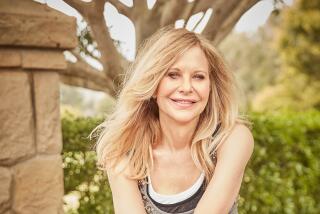Filmmakers do Yiddish theater a real mitzvah
Dan Katzir was a thirtysomething Israeli filmmaker on vacation in New York City when he was accosted by 84-year-old Zypora Spaisman on the subway. The bird-weight octogenarian had been a star and director of New York City’s Folksbiene, the oldest-running Yiddish theater in America, but when she met Katzir, she was in the midst of her last show, a production of 1916’s “Green Fields,” for the Yiddish Public Theater, which she founded in 2000.
The play was slated to close in eight days -- on New Year’s Eve -- and Spaisman, desperate to prevent that from happening, was not above soliciting help from attractive young strangers on the R train.
She invited him to see her perform. “I told her I have no plan on seeing a show in Yiddish, but she said, ‘Come, just see it,’ ” recalls Katzir, seven years later. “I just so fell in love with it.”
Doing his bit to help, Katzir got out his video camera to document Spaisman’s quest in “Yiddish Theater: A Love Story.” The film opened in limited release at the end of November and, thanks to strong reviews, has been gaining a steadily larger following among the art-house set ever since.
“As one of the characters in the movie says, ‘We live in a “Seinfeld” society,’ where everything is fast and quick and edgy but not very emotional,” Katzir says. “Meeting her and the [other actors], they’re funny, but they’re not cynical. This is an ode for this lost and disappearing culture, which still has something to teach all of us about the beauty of emotions.”
It’s easy to see why Katzir became entranced with Spaisman, who lost 150 family members in the Holocaust but resolutely says in the film, “Hitler couldn’t stop me. Stalin couldn’t stop me.”
Age will certainly not prevent her from doing what she loves best: acting. “Retirement is a death sentence,” she says in the film. “People have to live.”
The documentary is filled with others caught up in her forceful will, including various other elderly stars of the Yiddish theater like Shifra Lerer (who played Woody Allen’s character’s mother in “Deconstructing Harry”) as well as a young Israeli ingenue who learns her lines phonetically and a tattooed former Hassid from Williamsburg who wound up in his first play because he could speak Yiddish.
There’s also the middle-class couple who plowed $70,000 of their savings into the production, and Spaisman’s tireless producer, David Romeo, who trudges literally through mounds of snow, all across New York City, trying to raise the $50,000 or so it would take to allow them to move their well-reviewed production to another theater. It’s to little avail, as Katzir documents the minute-by-minute expiration of a dream.
His own story has had a happier ending.
On a recent morning, the former paratrooper is sitting at a Coffee Bean & Tea Leaf with his producer, the energetic Ravit Markus, not far from the Laemmle Monica, where their film has been playing for several weeks. Although Katzir has made 10 documentaries, including “Out for Love . . . Be Back Shortly,” which was a sensation in his home country and appeared on HBO here, getting “Yiddish Theater: A Love Story” seen has proved almost as daunting as trying to save Spaisman’s production.
“It took eight days of filming, 40 days of editing and seven years of waiting,” Katzir says. They were rebuffed in particular by countless Jewish organizations and film festivals, like the New York Jewish Film Festival, who told them that no one was interested in Yiddish theater.
“Yiddish was a valid culture for 1,100 years, and after World War II, so many Jews began hating this culture with a vengeance,” Katzir says. “Maybe some Jews began identifying with Nazi propaganda and began seeing Yiddish culture the way the Nazis saw it, with this kind of contempt. That’s sad, because Yiddish is a culture that brought out some of the greatest minds humanity ever had. Freud was a Yiddish speaker. Einstein came to see Yiddish plays. Sholem Aleichem. People forget all the great minds and great culture. They just see it as a culture that had 6 million members murdered, and people are maybe ashamed of it.”
Katzir says that his own grandmother, as a child, was part of an organization that roamed the streets of Tel Aviv getting people to speak Hebrew instead of Yiddish. “Even today, a lot of the things that people identify as American Jewish humor, it actually comes from the Yiddish stage.”
“They have this laughter through tears thing,” says Markus. “Sad things are said in a humorous way, and humorous things are said in a sad way. It’s part of the fact that for a lot of years, those Jews were living in a foreign country and they had to be subversive to say things, so it’s all very understated. This is a culture of understated humor.”
“Yiddish Theater: A Love Story” did wind up in a number of film festivals, and eventually the pair decided to forgo distributors and release the documentary themselves. Markus sent the film to Greg Laemmle, president of the Laemmle art-house chain in Los Angeles, who agreed to play it in his theaters if they could find a New York exhibitor.
A couple of days later, a programmer from New York contacted the pair through their MySpace page asking to see the film, and within days, the documentary was set to premiere at the Two Boots Pioneer Theater.
Sadly, Spaisman never got to witness the documentary’s success -- she suffered a fatal stroke when the theater closed -- but she remains an inspiration to others, including Katzir.
“She was not in it for the money,” he says. “She was into doing something she really loved and trying to do that as best she could. She didn’t care if she had a full house. The point was being on stage. It was what gave her the reason to wake up in the morning.”
More to Read
Only good movies
Get the Indie Focus newsletter, Mark Olsen's weekly guide to the world of cinema.
You may occasionally receive promotional content from the Los Angeles Times.






